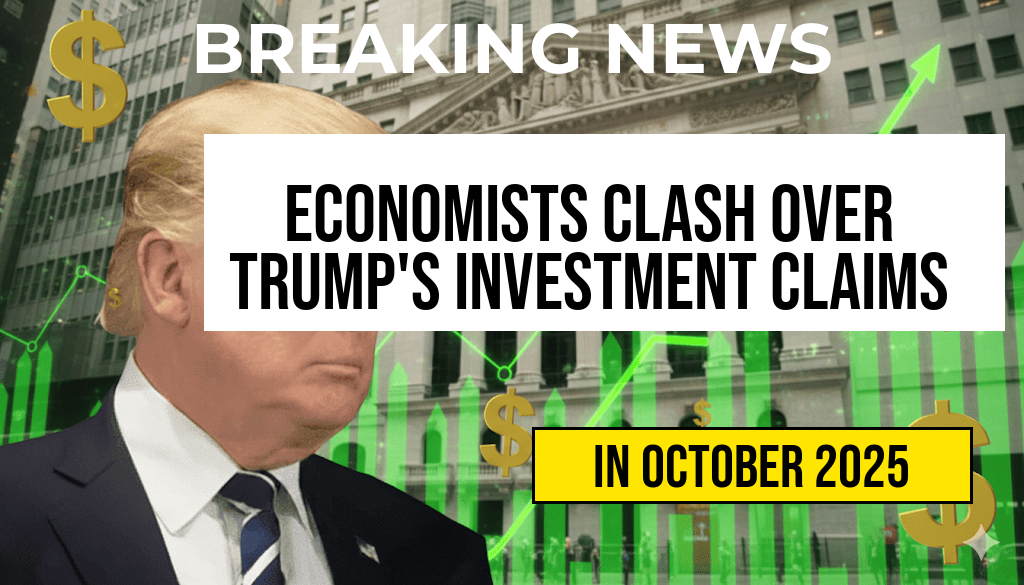Recent claims by former President Donald Trump regarding a potential $17 trillion global investment have ignited a heated debate among economists. During a rally in Michigan, Trump asserted that his administration laid the groundwork for this monumental investment, which he believes would transform the American economy and bolster international relations. However, experts are divided on the validity of these claims and the implications of such a figure in the current economic landscape. While some economists applaud the idea of increased investment, others question the feasibility and accuracy of Trump’s projections, raising concerns about inflation, market stability, and the role of foreign investment in the U.S. economy.
Understanding Trump’s Investment Claims
Trump’s statement suggests that his administration’s policies created a favorable environment for private investment both domestically and internationally. He pointed to tax cuts, deregulation, and trade agreements as key factors that supposedly spurred this growth. According to Trump, these policies laid the groundwork for a robust economy that could attract trillions in investments from around the globe.
Reactions from Economists
- Supporters: Some economists agree that Trump’s policies may have had a positive impact on business investment during his presidency. They argue that the corporate tax cuts provided companies with more capital to invest in growth and expansion.
- Critics: Conversely, a substantial number of economists dispute Trump’s claims. They contend that attributing a specific dollar amount to future investments is speculative at best. Critics emphasize the complexities of global markets and argue that economic growth is influenced by various factors beyond government policies.
The Feasibility of $17 Trillion
Assessing the feasibility of $17 trillion in global investment requires a closer look at current economic conditions and historical trends. According to a report by the Forbes, global foreign direct investment (FDI) flows have fluctuated dramatically, with a peak of around $1.9 trillion in 2021, followed by a decline due to geopolitical tensions and the ongoing effects of the pandemic. With this context, the figure Trump presents raises eyebrows among financial analysts.
Global Investment Trends
| Year | FDI in Trillions |
|---|---|
| 2019 | $1.54 |
| 2020 | $1.43 |
| 2021 | $1.9 |
| 2022 | $1.46 |
The unprecedented claim of $17 trillion seems to exceed historical norms, leading many to question the plausibility of such an investment influx. The Wikipedia entry on foreign direct investment notes that while the U.S. remains a significant recipient of FDI, attracting over $4 trillion in stock through 2021, the figures Trump cites would require a sustained and unprecedented increase in both domestic and foreign investment levels.
Potential Impacts on the U.S. Economy
If Trump’s assertions were to hold any merit, the implications for the U.S. economy would be profound. Increased investment could potentially lead to job creation, infrastructure development, and technological advancements. However, economists caution that such rapid investment could also exacerbate inflationary pressures and lead to market volatility.
Inflation Concerns
With inflation already a pressing issue in the U.S. economy, the prospect of a massive influx of capital raises concerns about overheating the economy. Economists warn that if demand outpaces supply due to sudden investment surges, prices could rise even further, impacting consumers and businesses alike.
The Political Landscape
The discussion surrounding Trump’s claims is also heavily intertwined with the political landscape as the 2024 presidential election approaches. As candidates position themselves for the election, economic narratives like Trump’s $17 trillion investment claim may play a pivotal role in shaping public perception and policy discussions.
The debate continues to unfold as economists analyze the implications of Trump’s statements. As the economic landscape evolves, the validity of such claims will remain a significant topic of discussion in both political and financial arenas.
Frequently Asked Questions
What is the main claim regarding Trump’s $17 trillion global investment?
The main claim is that Trump’s administration has facilitated or projected a $17 trillion global investment, which is a point of contention among economists regarding its accuracy and implications.
Why are economists divided on the $17 trillion investment figure?
Economists are divided because some believe the figure is inflated or misrepresented, while others argue that it could reflect potential future investments rather than actual capital already in motion.
What are the implications of these investment claims for the economy?
The implications of these claims could affect market confidence, foreign relations, and domestic economic policies, as investors and policymakers react to the perceived health of the economy.
How do critics view the $17 trillion investment narrative?
Critics view the narrative as a form of political posturing, arguing that it may serve more to enhance Trump’s image than accurately represent economic realities.
What evidence is provided by supporters of the investment claims?
Supporters of the investment claims may cite specific business deals and commitments made by companies during Trump’s tenure as evidence of increased investment activity, though these claims are often disputed by detractors.

Leave a Reply